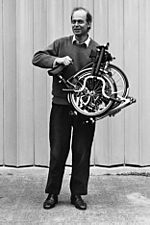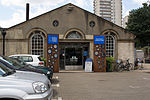Kew railway station (England)
1853 establishments in EnglandDisused railway stations in the London Borough of HounslowFormer North and South Western Junction Railway stationsLondon railway station stubsPages with no open date in Infobox station ... and 3 more
Railway stations in Great Britain closed in 1862Railway stations in Great Britain opened in 1853Use British English from January 2018
Kew railway station was opened by the North and South Western Junction Railway in 1853 in Brentford in west London on the western curve of the Kew triangle. It closed in 1862 after the railway had in 1862 opened its Kew Bridge platforms (closed since 1940) on the eastern curve and which were connected to the LSWR Kew Bridge station, itself on the southern chord. Although Kew and Kew Bridge are applied to structures on the north bank of the Thames Kew does not extend across the river.
Excerpt from the Wikipedia article Kew railway station (England) (License: CC BY-SA 3.0, Authors).Kew railway station (England)
Lionel Road South, London
Geographical coordinates (GPS) Address Website Nearby Places Show on map
Geographical coordinates (GPS)
| Latitude | Longitude |
|---|---|
| N 51.4906 ° | E -0.2916 ° |
Address
Magnet
Lionel Road South
TW8 9QR London (London Borough of Hounslow)
England, United Kingdom
Open on Google Maps










